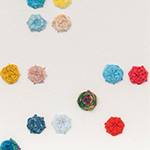Daydreamers, Majd Abdel Hamid’s first solo exhibition in London, brings together a new and ongoing series of needlework. Initiated as early as 2012, these evolving and, at times, concluded bodies of work emerge from specific social and political moments, appearing as what the artist describes as ‘textures of memory’.
Hamid engages with time as both material and medium, employing embroidery as a technique of recording, reflection and refusal. His work is guided by slowness and repetition, building up intensities of feeling over narrative enclosure, at odds with the accelerationist logic of algorithmic visual culture. If the modernist grid sought to impose order, his stitches waver – accumulations of attention, of intimate, even flawed, labour, and of time worked through, or ‘wasted’.
12-23 (End of Chapter) (2012–2023) is a series that began with nine embroidered portraits of Mohamed Bouazizi, whose self-immolation on 17 December 2010 catalysed the Arab Spring. Hamid invited a woman from Farkha village to embroider one portrait, who then invited seven others. Hamid embroidered the ninth, making it his first embroidery project – a portrait that would gradually reduce in form over a decade. As figuration eroded, what remained was the name: Bouazizi, sewn onto a pillowcase using the leftover threads from the original commissions. The process moved through cycles of repetition, renunciation and reappearance, mapping the artist’s own dislocations – moments of departure, guilt and acceptance – across shifting geopolitical landscapes.
A body of work made for this exhibition, Daydreamers (Fortune Tellers) (2025–), extends Hamid’s interest in non-prescriptive futures. Over six hundred fortune tellers, modelled after the children’s origami game, become a ‘carpet’ of possibilities across the gallery floor. Unlike the game’s usual predetermined answers, Hamid’s fortune tellers bear no inscriptions, only the textures of the folded fabric, leaving the act of divination open-ended. What is folded can unfold, unconcealing, or perhaps reverting back to its source material. Crafted laboriously, they will be offered to be taken freely, one for each visitor, over the exhibition’s final two weeks. In London, a city where time is hyper-optimised and monetised, Hamid proposes a small act of gifting – without inscription, without demand.
Daydreamers (Code) (2024–) seeks to introduce slippages within the binary zeros-and-ones logic of the Jacquard loom’s punch card, the machine that gave rise to automation and algorithmic coding. The series is made up of acts of unravelling and reconfiguring. It began with pieces of fabric collected by Hamid since his move to Beirut, materials accumulated but left unused. When already fraying, they are picked apart, then woven into small circles, building up texture. Each circle corresponds to a specific fabric, a trace of its former structure. The woven patterns appear as a ‘dysfunctional’ binary code, in the way one might absentmindedly scribble musical notes. The leftover fabric is then folded into fortune tellers.
The movement from one series to another is a continuous cycle of transformation: from fabric to thread, from thread to woven code, from leftover material to an object of potential. Hamid’s work unmakes the grid as a structure of control in favour of the imperfect, emerging rhythms of the hand. His practice draws on Palestinian textile traditions while remaining unbound by historical forms – using embroidery as a means of evading both the hierarchies of art historical canons and the pressures of ideological symbolism. His gradually accumulating body of thousands of hours of work is a commitment to slowness – a refusal of the now-ubiquitous temporality of algorithmic attention extraction, which takes hold over the qualitative sensation of time.
Daydreamers marks a point of departure in the artist’s practice. If earlier works carry the repetitive compulsion to work through, here is a sense of release – not an erasure or a resolution but an opening towards what remains possible. It is a meditation on how everyday acts of making may partake in the understated project of continuity, possibility, quiet joy, and life.
Curator Adomas Narkevičius
Press release from Cell Project Space
Image: Majd Abdel Hamid. Daydreamers (Code). 2024. Detail. 9 × 18 cm. Image courtesy of the artist and Cell Project Space



